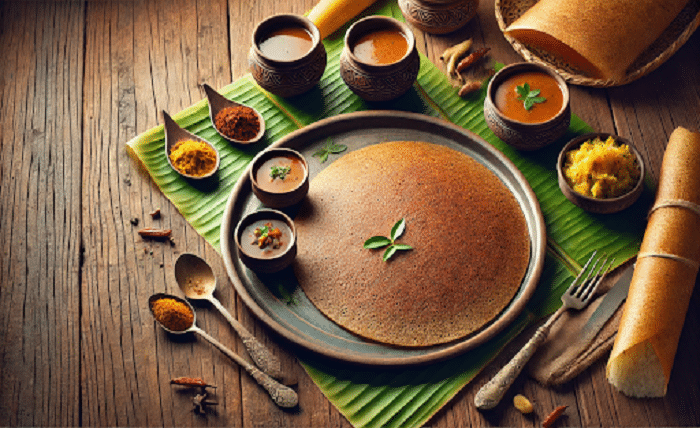Organic ragi flour, also known as finger millet, is a staple in many Indian households. This ancient grain has been cultivated for thousands of years and is celebrated for its impressive nutritional profile. In this article, we’ll explore the top five health benefits of Organic Ragi Flour, along with some delicious recipes to incorporate this superfood into your daily diet.
1. High Calcium Content
Ragi is one of the richest sources of calcium among plant-based foods. Calcium is essential for maintaining strong bones and teeth. This makes ragi particularly beneficial for children, women, and the elderly who need higher calcium intake.
According to the National Institute of Nutrition (NIN), 100 grams of ragi contains approximately 344 mg of calcium.
2. Rich in Iron
Iron deficiency is a common problem, especially among women in India. Ragi is an excellent source of iron, which helps in preventing anemia and boosting hemoglobin levels.
A study published in the Journal of Food Science and Technology highlighted that ragi contains about 3.9 mg of iron per 100 grams.
3. High in Dietary Fiber
Ragi Powder is rich in dietary fiber, which aids in digestion and helps prevent constipation. The high fiber content also helps in managing weight by keeping you full for longer periods.
According to a study in the International Journal of Food Sciences and Nutrition, 100 grams of ragi contains approximately 11.2 grams of dietary fiber.
4. Low Glycemic Index
Ragi has a low glycemic index, which means it releases sugar slowly into the bloodstream. This makes it an ideal food for diabetics and those looking to manage their blood sugar levels.
Research indicates that the glycemic index of ragi is around 54, which is considered low.
5. Packed with Antioxidants
Ragi is rich in antioxidants, which help combat oxidative stress and reduce inflammation in the body. These antioxidants are crucial in preventing chronic diseases such as heart disease and cancer.
A study in the Journal of Agricultural and Food Chemistry found that ragi contains significant amounts of phenolic acids and flavonoids, both powerful antioxidants.
Top 3 Recipes Using Organic Ragi Flour
1. Ragi Dosa
Ragi dosa is a healthy and delicious alternative to traditional rice dosa. It’s easy to prepare and perfect for breakfast.

Ingredients:
- 1 cup ragi flour
- 1/2 cup rice flour
- 1/4 cup urad dal
- Salt to taste
- Water
Instructions:
- Soak urad dal for 4-5 hours.
- Grind urad dal to a fine paste.
- Mix ragi flour, rice flour, and urad dal paste.
- Add water to make a batter of pouring consistency.
- Let it ferment overnight.
- Heat a non-stick pan and pour a ladleful of batter.
- Spread it in a circular motion to make a thin dosa.
- Cook until crispy and serve with chutney.
2. Ragi Ladoo
Ragi ladoo is a nutritious and sweet treat that’s perfect for festivals or as a healthy snack.

Ingredients:
- 1 cup ragi powder
- 1/2 cup jaggery
- 1/4 cup ghee
- 1/4 cup grated coconut
- 1/4 tsp cardamom powder
Instructions:
- Dry roast ragi powder in a pan until aromatic.
- Add grated coconut and roast for another 2 minutes.
- In another pan, melt ghee and add jaggery.
- Stir until jaggery dissolves completely.
- Mix the ragi powder and jaggery mixture.
- Add cardamom powder and mix well.
- Shape into small ladoos and let them cool.
3. Ragi Porridge
Ragi porridge is a wholesome and nutritious meal, especially beneficial for growing children.
Ingredients:
- 1/2 cup ragi flour
- 2 cups water
- 1 cup milk
- Jaggery or honey to taste
- A pinch of cardamom powder
Instructions:
- Mix ragi flour in water to avoid lumps.
- Cook on medium heat until it thickens.
- Add milk and continue cooking for another 5 minutes.
- Sweeten with jaggery or honey.
- Add cardamom powder and serve warm.
True Story Organics and Organic Ragi Flour
At True Story Organics, we believe in offering the highest quality organic ragi flour, ensuring that you and your family reap all the health benefits of this super grain. Incorporating organic ragi flour into your diet is a great way to enhance your nutritional intake naturally.
FAQs
1. What are the health benefits of organic ragi flour?
Organic ragi flour is rich in calcium, iron, dietary fiber, has a low glycemic index, and is packed with antioxidants.
2. How can I use ragi flour in my daily diet?
You can use ragi flour to make dosa, ladoo, porridge, and various other dishes.
3. Is ragi flour suitable for diabetics?
Yes, ragi flour has a low glycemic index, making it suitable for diabetics.
4. Can children consume ragi flour?
Yes, ragi flour is excellent for children due to its high calcium content and nutritional benefits.
5. Where can I buy organic ragi flour?
You can buy high-quality organic ragi flour from True Story Organics.
6. How should I store ragi flour?
Store ragi flour in an airtight container in a cool, dry place to maintain its freshness.
7. Are there any side effects of consuming ragi flour?
Ragi flour is generally safe to consume. However, excessive intake may lead to gastrointestinal discomfort for some individuals.
In conclusion, incorporating organic ragi flour into your diet can offer numerous health benefits. Whether it’s through delicious recipes like ragi dosa, ladoo, or porridge, this superfood can significantly enhance your overall well-being. Have you tried any ragi recipes yet? If not, which one will you try first?





